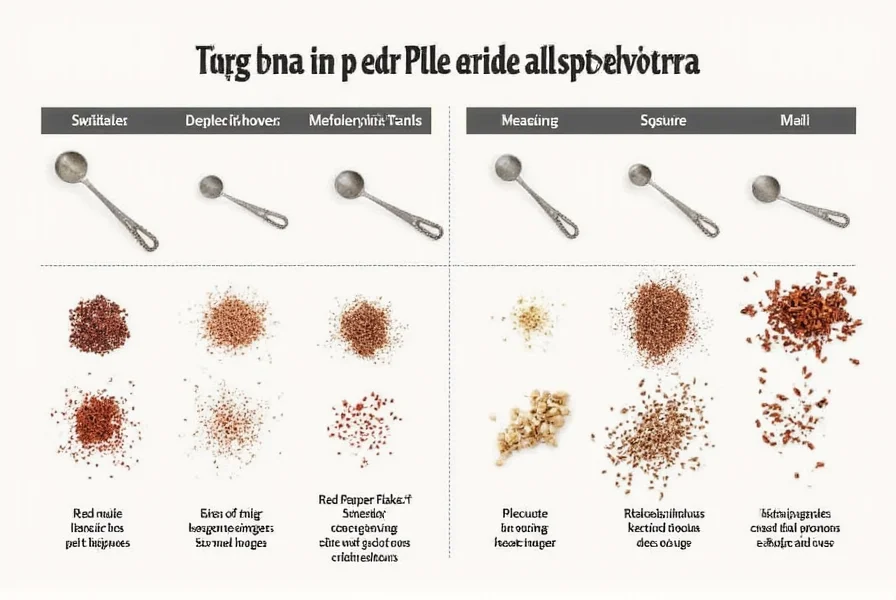The three best immediate substitutes for red pepper flakes are: 1) Crushed red pepper (use 1:1 ratio), 2) Cayenne pepper (use 1/3 amount), and 3) Chili powder (use 2-3 times the amount). For milder heat, try paprika with a pinch of cayenne. Fresh chopped jalapeños or serranos work well in sauces and salsas.
Running out of red pepper flakes doesn't have to derail your cooking plans. Whether you're making pizza, pasta, or stir-fry, these practical alternatives deliver similar heat and flavor profiles when used correctly. Understanding the nuances between substitutes ensures your dish maintains the intended spice level and complexity.
What Are Red Pepper Flakes?
Red pepper flakes, also known as crushed red pepper, typically consist of dried and crushed cayenne peppers mixed with other chili varieties. They provide moderate heat (30,000-50,000 Scoville units) with earthy, slightly smoky notes. The flakes contain both seeds and flesh, creating a balanced heat that builds gradually rather than hitting all at once.
Top Substitutes for Red Pepper Flakes
Cayenne Pepper
Cayenne offers the closest heat profile but lacks the textural element of flakes. Since it's ground finer and more potent, use only one-third the amount called for in your recipe. For example, if a recipe requires 1 teaspoon of red pepper flakes, substitute with 1/3 teaspoon cayenne. This works particularly well in sauces and marinades where texture matters less.
Crushed Red Pepper
Often confused with red pepper flakes, crushed red pepper is essentially the same product. Check your pantry—many households keep both without realizing they're interchangeable. Use these as a 1:1 substitute in any recipe requiring red pepper flakes.
Chili Powder
Most commercial chili powders contain a blend of chilies plus cumin, garlic powder, and oregano. For recipes where additional spices won't interfere (like chili or taco seasoning), use 2-3 times the amount of red pepper flakes called for. For dishes requiring pure heat without additional flavors, look for pure ground cayenne or ancho chili powder.
Fresh Chili Peppers
For immediate cooking needs, fresh jalapeños, serranos, or Thai chilies provide excellent alternatives. Finely chop 1 fresh serrano pepper to replace 1 teaspoon of red pepper flakes. This substitution works best in salsas, stir-fries, and dishes where fresh ingredients complement the recipe. Remember that fresh peppers deliver brighter, more immediate heat compared to the gradual warmth of dried flakes.
Paprika with Cayenne Boost
When you need a milder substitute, combine 1 teaspoon paprika with 1/8 teaspoon cayenne for every teaspoon of red pepper flakes. This blend maintains the visual appeal of red pepper flakes while allowing precise heat control. It's ideal for dishes where intense heat would overwhelm other flavors, such as in creamy pasta sauces or delicate seafood dishes.
Substitution Ratio Reference
| Substitute | Ratio to Red Pepper Flakes | Best For |
|---|---|---|
| Cayenne pepper | 1:3 (1/3 amount) | Sauces, marinades, baked goods |
| Crushed red pepper | 1:1 | All applications |
| Chili powder | 2:1-3:1 | Chili, tacos, hearty stews |
| Fresh serrano/jalapeño | 1 pepper:1 tsp | Salsas, stir-fries, fresh dishes |
| Paprika + cayenne | 1 tsp + 1/8 tsp | Creamy sauces, mild dishes |
Recipe-Specific Substitution Guide
Certain dishes benefit from specific substitutes. For pizza and pasta dishes where visual appeal matters, crushed red pepper or a paprika-cayenne blend maintains the signature red speckles. When making hot honey or infused oils, cayenne dissolves more evenly than fresh peppers. For Asian cuisine, Korean gochugaru provides similar heat with distinctive flavor notes.
Consider the dish's cooking time when selecting substitutes. Long-simmered dishes like chili or tomato sauce can handle more potent substitutes since heat mellows during cooking. For finishing dishes like avocado toast or finished pasta, milder options prevent overwhelming other flavors.

Creating Your Own Red Pepper Flakes Substitute
When pantry staples combine for a custom blend: mix 2 parts paprika, 1 part garlic powder, and 1/2 part cayenne. Store in an airtight container for up to six months. For a more authentic texture, dry and crumble mild chili peppers like Anaheim or New Mexico varieties.
Homemade blends allow customization for dietary needs. Those with sensitive stomachs can reduce the cayenne proportion while maintaining flavor complexity. For gluten-free requirements (some commercial blends contain anti-caking agents with gluten), homemade versions guarantee purity.
Storage Tips for Substitutes
Ground spices lose potency faster than whole peppers. Store cayenne and chili powder in dark glass containers away from heat sources. Fresh peppers maintain quality for 1-2 weeks in the refrigerator's crisper drawer. For long-term storage, freeze chopped fresh chilies in ice cube trays with a bit of water, then transfer to freezer bags.
When Substitutes Won't Work
Some recipes rely specifically on the texture of red pepper flakes, such as certain bread coatings or as a visible garnish. In these cases, no substitute perfectly replicates both the visual and textural elements. Consider adjusting the recipe instead—sprinkle alternative spices underneath cheese on pizza so they melt into the sauce rather than sitting on top.










 浙公网安备
33010002000092号
浙公网安备
33010002000092号 浙B2-20120091-4
浙B2-20120091-4